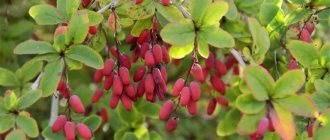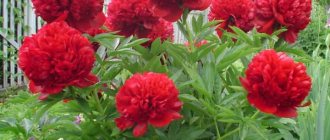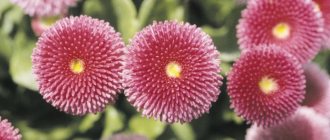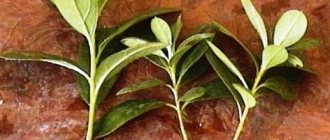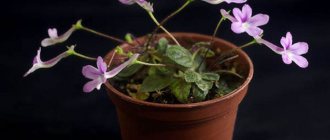Propagation by seeds at home
Euphorbia is propagated by seeds at the end of summer , when seed pods appear, but it can also be sown in the “classical time,” that is, in the spring (the specific time depends on the region and is not related to temperature, but to the length of daylight hours).
Advantages and disadvantages
The method is simple, does not allow preserving varietal characteristics, so it is not suitable for those who plan to propagate plants of a certain variety, and is not so profitable when growing for sale.
How to choose seeds?
Seeds can be collected independently from a crop or purchased in a store . Seeds are taken from a healthy plant; they must be undamaged, not empty, not overdried.
Step-by-step instructions: how to plant?
- The seeds are buried in moist soil; several seeds are placed in one pot.
- The choice of further actions depends on preferences.
Some plant growers claim that subsequent compliance with the microclimate and soil cover is not required, while others recommend creating a microgreenhouse by covering the top of the pot with glass/polyethylene/cut plastic bottle.
How to grow seedlings and when to plant?
Seedlings are grown at normal room temperature, but not lower than 20 degrees with sufficient light. When the first shoots appear, the covering material is removed .
Watering corresponds to the drying of the soil; do not forget that this is not a moisture-loving plant. It is necessary to spray, especially if the room is dry.
Transplantation of seedlings to a permanent place is done when 2-3 leaves appear, when the sprouts have finally become stronger.
Types and varieties of plants
Euphorbias can be found throughout the world, from temperate to tropical zones.
o one of the largest and most complex genera in the plant kingdom. Several attempts to divide them into smaller genera have failed, as new species are discovered again and again. They range from annual plants that creep along the ground to well-developed leafy shrubs and trees that can reach 20 meters. In the deserts of Madagascar and southern Africa, convergent evolution has led to succulent forms, where the plants occupy the same ecological niche as cacti in the deserts of the Americas.
The unique floral structure consists of colorful bracts in yellow, red, purple, brown or green with tiny male and female floral parts in contrasting tones.
Ornamental varieties, of which there are about 120, generally prefer sun and dry soil. However, Griffith's milkweed, as well as swamp milkweed, thrive in moist soil. The evergreen perennial Euphorbia myrtifolia thrives in dry soil in full sun but is quite tolerant of rocky and sandy conditions. It reproduces spontaneously by seeds, so dried flowers should be removed immediately to limit unwanted growth. Its bluish-green, fleshy, succulent-like leaves are arranged in spirals close to the stems, growing from a descending woody base to a height of 10-20 centimeters. Prefers warm winter climates and leaf drop usually occurs in cold climates.
Most ornamental milkweeds grow in zones 6-9, with a few species tolerating climate zones 10-11, but there are a few evergreen species that are adapted to the temperate climates of zone 5, like cypress milkweed, a source of charm in the garden thanks to its interesting flower heads.
A showy plant that produces fragrant lemon-yellow bracts that turn pinkish-orange as they mature. A forest of tiny flowers in umbrella-shaped clusters appears in late spring or early summer. The foliage resembles a miniature cypress, hence the name. As a rule, it lives up to 12 years and grows up to 30 centimeters. The upright, branching plant can spread aggressively as a dense grass cover if its space is not limited. Remaining attractive throughout the growing season, cypress spurge is resistant to most pests and diseases and does not require special care.
Cuttings
The perennial is propagated by cuttings or by dividing the mother plant in early or mid-spring in order to have time to separate the planting material from the plant before active growth of milkweed begins. The choice of such a time is not accidental - in this way the possibility of a stressful situation can be eliminated, in the light of which the plant could get sick or die.
Some gardeners prefer to divide perennials in early autumn to give the young crop more time to adapt and take root.
Pros and cons of the method
The advantages include the fact that the method makes it possible to preserve the varietal characteristics of the plant in its “new life”; the disadvantages are the need to take a fairly large fragment, which can adversely affect the appearance of the “donor”.
How to prepare cuttings?
Planting material is taken from the healthiest and most beautiful plant . It is better not to touch young plants, but to take cuttings from an adult perennial.
How to root a shoot?
Cuttings are carried out in several steps.
- A shoot at least five centimeters long is taken from a healthy plant. The cut area on the plant does not need to be treated.
- The cuttings can be rooted immediately or allowed to dry for 1-2 days. Rooting is done immediately in a permanent container, so as not to replant and stress the plant later.
- The soil needs to be well moistened (but do not overdo it, otherwise rotting may occur), after which the plant is covered with film or glass to create a microclimate.
- It is necessary to maintain a constant temperature of at least 20 degrees and sufficient lighting. As a rule, rooting occurs after 2-3 weeks.
Pest and insect control
The most common pests of milkweed are aleurodids (whiteflies) and spider mites. They feed on the plant, weaken it and ultimately kill it. Insect populations increase rapidly in a short time and the best chance to control them is to get rid of them early by spraying with mineral oil-based pesticides.
Milkweed diseases, root rot and powdery mildew, will not be much of a problem if the plant is provided with well-drained soil and air circulation. Root rot makes itself felt by the appearance of brown stems and the fact that the plant bends. The affected areas will need to be trimmed. Euphorbia is treated for fungal infection with fungicides.
How to propagate by dividing a bush?
Euphorbia can also be propagated by dividing the donor plant . In this case, “good health” is also necessary, as well as the presence of several trunks.
As practice shows, separated parts quickly adapt to new conditions and continue development in a separate container.
Advantages and disadvantages of the method
One of the advantages is good survival rate . The disadvantages include the fact that only bush varieties are suitable for this method; in other cases, only propagation by cuttings is suitable.
How to choose and prepare a bush?
No special preparation is required. As in all other cases, it must be an “exemplary in all respects” bush in terms of appearance and condition. Before dividing, the soil is watered; the procedure is carried out carefully so as not to damage the roots and the plants themselves, since some of the varieties are easy to break.
Step-by-step instructions for rooting
The procedure is simple and is performed in several steps.
- An adult euphorbia along with a lump of earth is removed from the pot, excess soil is removed to a minimum, and the condition of the root system is simultaneously checked.
- Then the shoots are carefully separated. It is optimal to take two to four new plants (depending on size and age).
- Each shoot takes root in a separate container with prepared soil of the composition indicated at the beginning of the article. The shoots need some time to recover from stress and adapt to new conditions, so growth will not be as vigorous at first.
General information
A large succulent plant native to Madagascar and subtropical regions of Africa. The stem is thick, fleshy, triangular. Well-defined ribs are covered with small spines. At the tops there are small oblong leaves. In nature, it grows on hills in the form of fancy shrubs or trees.
In an apartment, an adult triangular spurge reaches 2-3 meters, often resting on the ceiling. The bush is branched, with many side shoots. Its shape is often compared to a candelabra. There is a variety with a reddish stem and crimson leaves, which is considered a rare variety. Long-lived, retains high decorative properties throughout the entire period.
Features of breeding in open ground
- Growing euphorbia in open ground will not cause much trouble.
But only garden species of milkweed are suitable for this, and these are mostly perennials. The plant feels good in sunny places and in partial shade, although in the latter case it does not bloom so profusely, so such areas are more suitable for decorative deciduous varieties that can be grown as a “carpet”. - Even indoor spurge propagates well by seeds sown, as a rule, in the spring, and when carried by the wind they easily sprout anywhere in the area.
Having discovered such seedlings, you can dig up the plant and transplant it where you need it, although, despite its unpretentiousness, the plant does not like replanting and takes a long time to adapt, lagging behind bushes sown with seeds in growth. - In warm regions of the country, annual milkweed seeds are sown in early spring, in colder regions - through seedlings or sowing seeds before winter (late autumn), they will undergo natural stratification and grow stronger.
A month after the sprouts appear, the plant can be replanted, or, if sowing was already done in a permanent place, the plantings are thinned out. Planting of finished seedlings in the ground occurs when the threat of frost has passed. When planting using the division method, time does not matter. Some varieties require the installation of a support to which the seedling is tied after planting. The pruning rules are simple, shoots are removed as needed, this will stimulate re-blooming at the end of the season. - The bushes are fed once or twice a season with mineral fertilizers for garden plants, but you can also take those intended for indoor plants. Most varieties of euphorbia tolerate winter well without shelter, but in cold regions it is better to cover the bushes with spruce branches, sawdust, and covering material.
Euphorbia species and varieties
Mainly perennial species of milkweed are grown in culture, and among the annuals we can distinguish edged milkweed . This is a plant that reaches 80 cm, the leaves are rounded, during the flowering period the edge of the leaf changes color to white.
Popular perennial species include:
Euphorbia Mila is a plant that forms a large thorny bush, the leaves are small. The inflorescences consist of small flowers of red or yellow color.
Euphorbia white-veined - attracts with its resemblance to a palm tree, as well as with leaves on which white veins are located. Unfortunately, over time the veins lose color.
Euphorbia triangularis - grows very tall. All covered with thorns. The leaves are small and sharp. Due to its appearance, this plant is sometimes confused with a cactus. Flowering does not occur indoors.
Cypress spurge - this flower is more suitable for the garden, but since it multiplies too quickly and this often causes trouble, this spurge is grown indoors. But if you still decide to plant it in the garden, then growing it will be very easy, since it requires virtually no care.
Euphorbia Pallas is a low flower with a rhizome similar to ginseng and sometimes charlatans even pass it off as ginseng.
Multifloral Euphorbia is a very attractive plant that forms a clump that produces many yellow flowers.
Spurge spurge - this plant does not have a very attractive appearance and is very rarely grown as an ornamental.
to contents
Photo
Next, you can see in the photo what milkweed flowers look like when properly planted and cared for.
Undoubtedly, spurge is a very original and unusual plant. And every gardener wants to see this handsome man on his windowsill or in the garden. But many people have a question: can it be kept at home, why is spurge dangerous? For those who doubt whether or not to purchase this plant, we have prepared publications about the benefits and harms of milkweed.
Diseases and pests
- If your milkweed has dropped its leaves , there may be a problem with the roots. Due to the abundance of moisture, rotting could begin. You need to dig up the flower, cut off the rot and replant it in new soil.
- Most often, milkweed leaves turn yellow or red, and then fall off due to a lack of nutrients.
- Leaves can also dry out and fall off if they are infected with spider mites.
- If after replanting the plant has limp, drooping leaves , then most likely there is no reason to worry, the plant has simply experienced stress and is now slowly recovering.
to contents
chvetochki.ru
How to care for the first time?
A plant propagated by any method requires provision of normal conditions. In order for euphorbia to take root faster and actively begin to grow, the location and light parameters must be correctly selected.
Tolerates sunny places well, but without contact with sunlight , but drafts are also undesirable. Window sills on the side with a moderate degree of lighting work well.
If the plant is in the shade, then in winter it may need additional illumination with a phytolamp, but the type of milkweed also matters here; some varieties tolerate the lack of light better, and some - worse, although flowering species may stop blooming in such cases.
Euphorbia does not like excess humidity and abundant watering , this can cause deterioration of the condition. Indoor spurge should be watered more only during the period of active growth and if the air in the room is dry, and garden species - in dry summers.
The same applies to spraying. Excess moisture can be recognized by a change in color to a paler color and a decrease in the number of leaves.
However, complete drying out of the soil should also not be allowed . There are no strict temperature requirements; the plant tolerates a wide range of temperatures (from 16 to 24), however, sudden changes should be avoided.
In the warm season, you can keep it on the balcony, terrace, veranda, but you should not take the spurge there during the hot period, you need to accustom it to street conditions gradually.
A young plant needs periodic feeding.
The optimal solution is a complex fertilizer for succulents , which can be used year-round. Feeding is carried out no more than once every two months in winter and autumn, once a month in spring and summer.
Garden species are fed twice or thrice a season with mineral fertilizers.
In autumn, it is recommended to mulch plants (peat, humus, sawdust), and in cold regions to cover them for the winter (spruce branches, covering material, polyethylene, etc.). The need for pruning depends on the variety.
Correct pruning allows you to form a beautiful crown and increase the lushness of the bush, but if you have no experience in this matter, then it is better not to experiment, otherwise the plant will have to be thrown away, since it is difficult to correct unsuccessful pruning of milkweed due to the not very lush crown.
Faded buds and dried leaves must be removed . Young plants are replanted annually, each time increasing the volume of the pot.
The soil is selected depending on the variety, but the variations in composition are not too different. Both flowering and decorative foliage varieties can be grown in a universal substrate. It is recommended to replant adult plants every three to four years. Rooting is most effective in the spring.
All the features of caring for milkweed are described in detail in this article.
As a conclusion, we can say that growing milkweed is not difficult (if only for beginners), but it looks quite attractive and will fit harmoniously into any interior, and there is a place for it in the garden that it will transform.
Perennial garden spurge - nuances of cultivation
If it were necessary to give a general description of all plants of the genus Euphorbia, which has about 2000 species, then this is a special juice that has the texture of milky latex and irritates the skin.
Gloves should be worn when handling the plant, especially if there are open cuts or scratches on your hands. A large number of species are decorative varieties. All are characterized by the absence of flower petals and sepals, but instead have brightly colored modified leaves known as bracts that cover the plants like flowers in the spring.
Caring for milkweed is simple. It needs a little pampering before the plant takes root, but once that happens it's practically self-sufficient. It happens that milkweed dies from excessive care and watering rather than from neglect.
Euphorbia looks better if you allow it to grow freely, but when space is limited, you will have to maintain its shape. However, routine pruning is not required; it is enough to take care of the plant when it begins to look unattractive.
